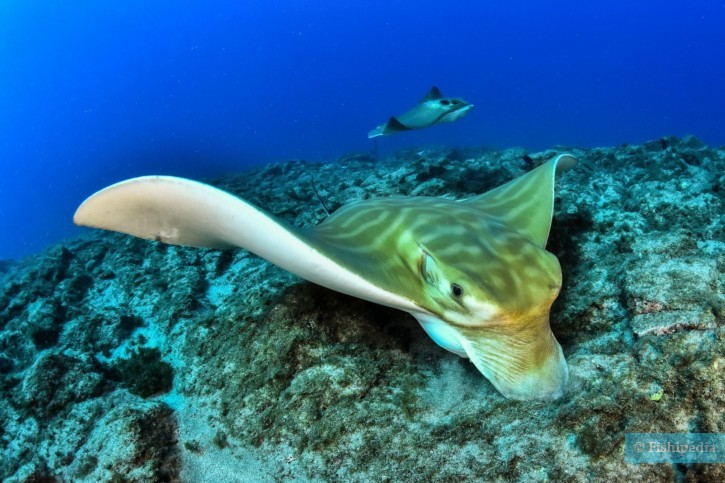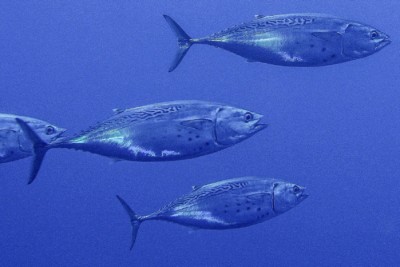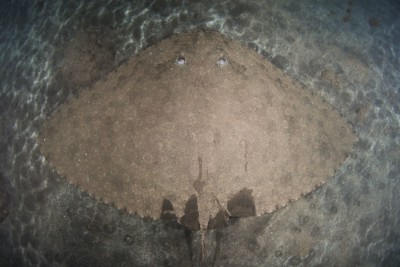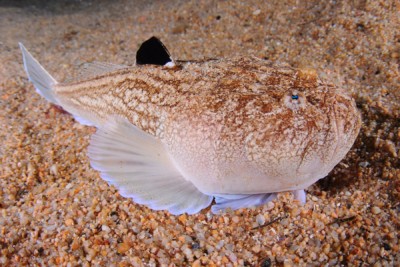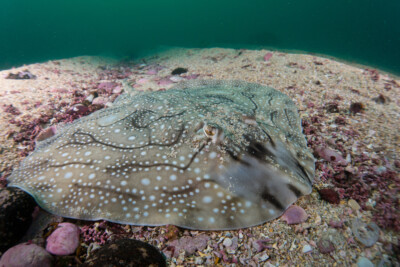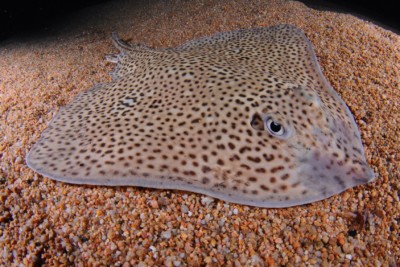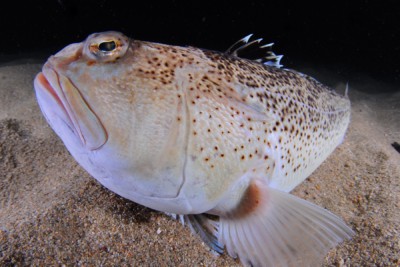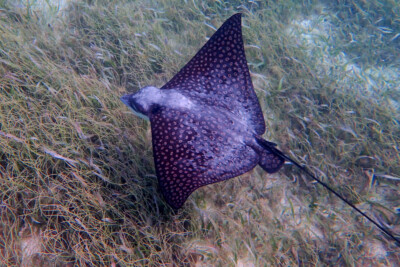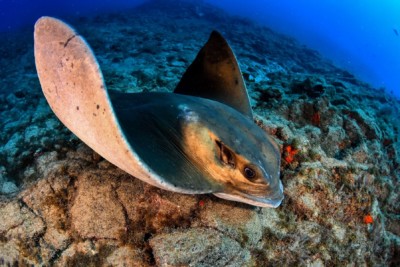duckbill eagle ray
| Family | Myliobatidae |
|---|---|
| Genus | Aetomylaeus |
| IUCN category (World) | CR |
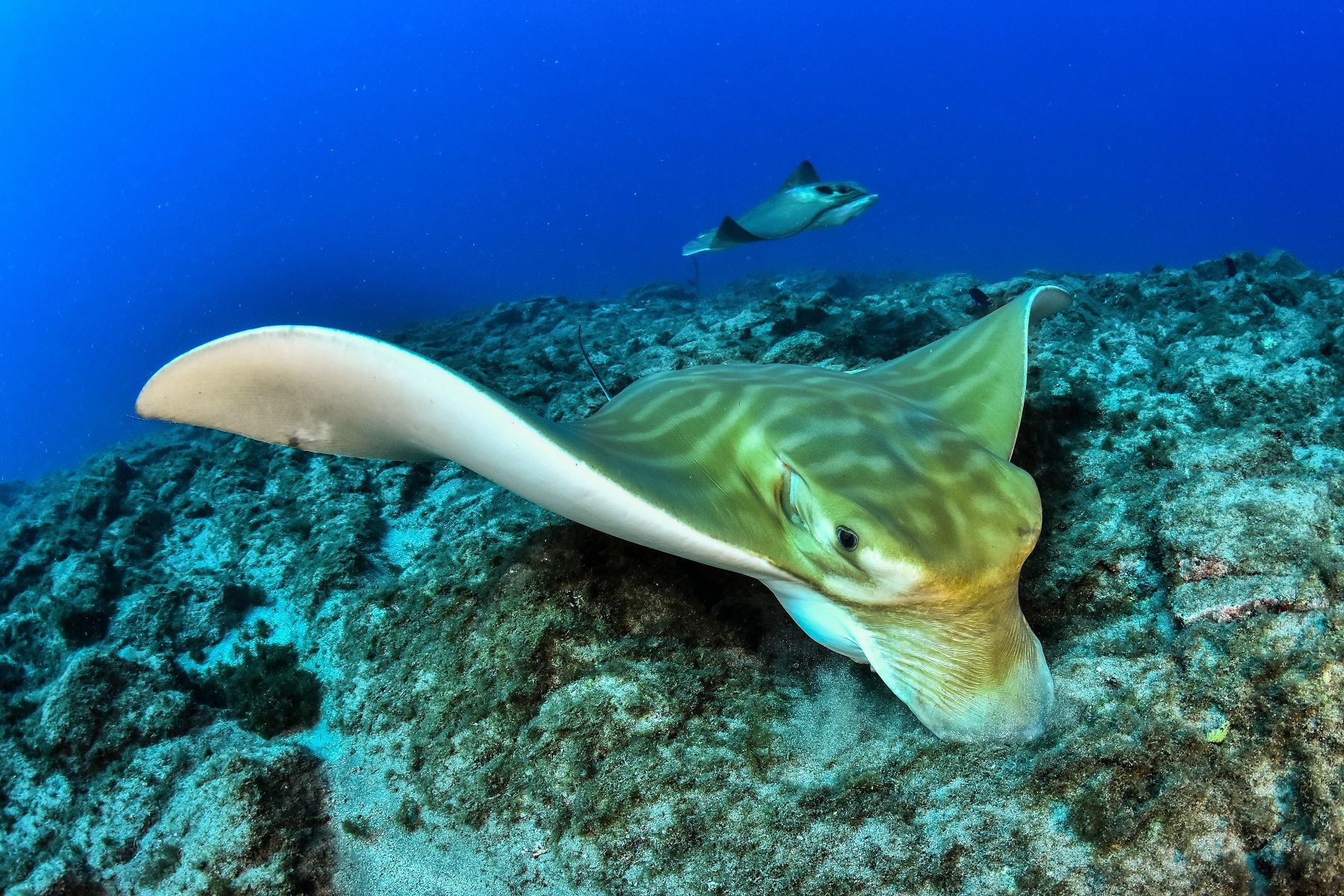

Introduction
Aetomylaeus bovinus, commonly known as the duckbill eagle ray, sometimes simply eagle ray, can measure over two meters, making it one of the largest rays known in the Mediterranean. It is found in the tropical and warm waters of the eastern Atlantic Ocean.
Still poorly studied today, it appears to be endangered in the Mediterranean Sea and the Black Sea. It has almost disappeared from the Aegean Sea. Populations in the Atlantic Ocean may be slightly more spared. Its main threats are overfishing and accidental captures.
Who is it?
Morphology
-
Type
-
Average size150 cm
-
Maximum size220 cm
-
Mimicrysand
-
Type
-
Average size150 cm
-
Maximum size220 cm
-
Mimicrysand
How to recognize This fish ?
This species is easily distinguishable from other rays. The body is brown-beige with several light blue stripes on the back. The belly is white. The snout is long and flat, resembling a duck's bill. The head is imposing. The mouth contains 7 rows of flat teeth.
Sexual dimorphism
Males and females are very similar, but the largest individuals are all females.
Behaviour & Life cycle
-
dietcarnivorous
-
Sociabilityliving in a group or alone
-
territorialNo
-
Way of livingdiurnal
The duckbill eagle ray lives in groups or alone. It is mobile, generally frequenting coastal areas but is sometimes seen further offshore.
It naturally resides near the seabed, foraging for crustaceans and mollusks. It particularly seeks out mussels, oysters, and gastropods. It has been recorded in brackish waters. This species appears to be migratory; females gather in nurseries annually to give birth.
Reproduction
-
Reproductionovovivipare
-
Migratory speciesYes
The duckbill eagle ray is an ovoviviparous fish. The embryos are incubated within the mothers.
Initially, they feed alone on egg yolk and then receive a supplemental diet from the mother through indirect absorption of uterine fluid enriched with mucus, fat, or proteins. This feeding mode follows a complex structure.
Gestation lasts approximately 6 months, with 3 to 7 fully formed young born, already measuring 45 cm at birth.
Risks for humans
-
VenomousNo
The species appears to be harmless to humans. However, caution should be exercised when encountering large individuals.
Origin and distribution
Geographic distribution & Conservation
Mediterranean populations are declining. It has become rare throughout this area and could disappear if no conservation measures are taken.
Conservation status of populations (IUCN)
What is its habitat?
Natural environment characteristics
-
Depth10 - 150 m
Biotope presentation
This species is mainly found near sandy, muddy, or rugged bottoms (algae, pebbles...). It is more common between 10 and 150 meters but can be spotted at the surface.
Species of the same biotope
To go further
Sources & Contributions
Participation & Validation
The Fishipedia team and specialist contributors are committed to providing high-quality content. However, although the information comes from scientific sources or testimonials from specialists, the cards may contain inaccuracies.

Benoit Chartrer
Translation
Translation done with the valuable contribution of our translators, who make this information available to a wider audience. We sincerely thank them for their commitment.

Marine Kassel
Bibliographic references
- - GBIF
- - A revised generic arrangement for the eagle ray family Myliobatidae, with definitions for the valid genera - WILLIAM T. WHITE - ZOOTAXA - 2014.
- - Bull ray, Aetomylaeus bovinus (Geoffroy Saint‐Hilaire, 1817) (Myliobatidae) in the Mediterranean Sea and captures of juveniles from Izmir Bay (Aegean Sea, Turkey) - O. Akyol - I. Aydın - O. El Kamel-Moutalibi - C. Capapé - WILEY - 2017.
Scientific partners
Tags
#Myliobatidae
#Aetomylaeus
#fonds sablonneux
#plein eau
#zones côtières troubles
#zones d'algues et de détritus végétaux
#Ray
#Mediterranean Sea
#Black Sea
#Océan Atlantique Est Afrique - Angulhas
#Océan Atlantique Est Afrique - Bengala
#Océan Atlantique Est Afrique - Golfe de guinée
#Temperate Eastern Atlantic Ocean
#Océan Atlantique Est Afrique - Transition & Cap Vert
#Eastern tropical Atlantic Ocean
#Canary Islands
Species of the same family
Species of the same biotope
